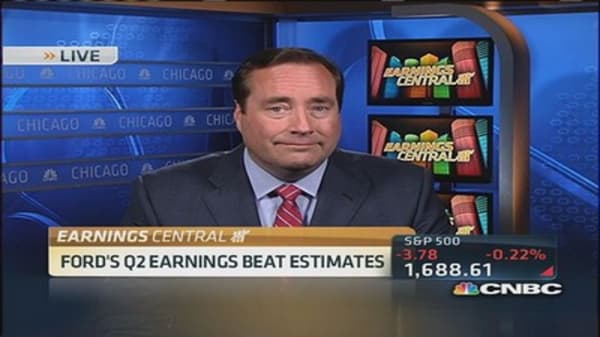Ford may need to borrow from Coca-Cola's old advertising playbook and make a song: "I'd Like to Buy the World a Ford."
That's because the automaker is on a path to become the favored auto brand of the world after demonstrating strong quarterly results in all major global regions. This transformation could lift Ford shares 30 percent and break them away from the unfair lockstep they trade in with shares of General Motors, investors and analysts said.
"Ford is one of the few companies seeing better results in the U.S, China and Europe," said Michael Murphy, president of Rosecliff Capital, who owns the shares. "CEO Mulally's plan for Europe will work. It's very similar to the plan he laid out for the US."
Last week, Ford said sales increased 15 percent, three times the global industry average, as calculated by Morgan Stanley.
The "One Ford" strategy by Mulally started with the divestiture of non-core brands like Aston Martin, Jaguar, Land Rover and Volvo. It's continued with the implementation of a single manufacturing architecture (and in most cases, the same brand name) for a car sold in U.S., Europe, China or Russia. The global convergence in tastes for vehicles is allowing Ford to capitalize on this strategy of using the same frames and parts for all cars around the world.
The key example: Ford Escape, which first caught fire first overseas as "the Kuga" with its SUV feel, yet almost compact size. It's now one of their fastest sellers in North America.
"Ford has streamlined its operations substantially under the One Ford strategy," wrote J.P. Morgan's Ryan Brinkman, who has a $22 price target on the stock, in a note to clients. "Its management, designers and engineers around the world are now squarely focused on supporting the core Ford brand."
(Read more: Americans are driving less, and here's why)
International operations lost only $20 million in the second quarter versus J.P. Morgan expectations for a loss of nearly $600 million. The company unexpectedly turned a $177 million profit in the Asia Pacific region and management seems to be well ahead on its goal to break even in Europe by mid-decade.
"They are struggling to keep up with demand in China and with three new plants on the way, we're still in early days here," said Adam Jonas of Morgan Stanley. He notes that crossovers and SUVs are catching on in China and Ford's market share is approaching 5 percent.
"Asia could add a new leg to Ford story," notes Colin Langan of UBS. "The result finally shows the benefit from years of investment in the region and lends confidence to Ford's goal of Asia being a material profit contributor by mid-decade."
July new U.S. car sales announced this Thursday are expected to jump 16 percent, according to Kelley Blue Book.
"F-150s are tied to housing/construction and demand in the U.S. is very strong," said Rosecliff's Murphy. "There are big margins in pickups for Ford."





